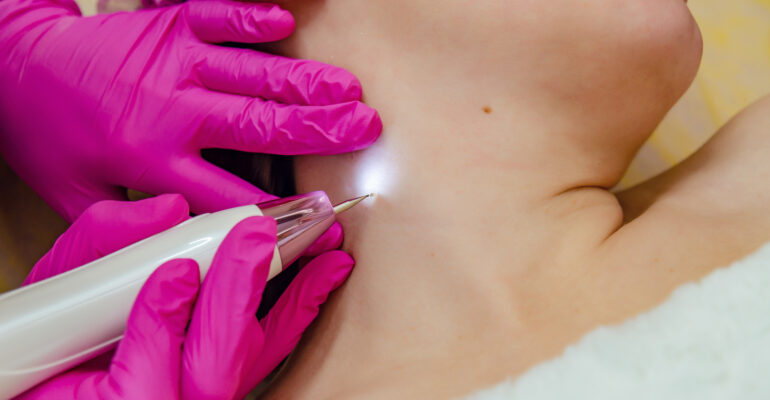Skin Tag Removal: Why and How to Remove Skin Tags
November 5, 2023 2023-11-05 7:58Skin Tag Removal: Why and How to Remove Skin Tags
As an Amazon associate, Dermatocare earns from valid purchase made by clicking on the affiliate links in this blog.

Skin Tag Removal: Why and How to Remove Skin Tags
Skin tags are a common skin condition that can develop on various parts of the body. They are benign growths that often occur in areas where skin rubs against skin, such as the neck, armpits, and groin. While skin tags are harmless, they can be bothersome and unsightly, leading many people to seek ways to remove them.
Understanding Skin Tags
Skin tags are common, benign skin growths that often appear in adults. They are also known as acrochordons and are usually small, flesh-colored or slightly darker, and have a stalk that attaches them to the skin. Skin tags typically develop in skin folds, where skin rubs against skin, such as on the neck, underarms, groin, and abdomen.
While skin tags are generally harmless, they can be bothersome if they become irritated or caught on clothing or jewelry. People who are overweight, pregnant, or have loose skin are more likely to develop skin tags. However, anyone can get them, and they tend to become more common as people age.
Skin tags are not contagious, and they are not a sign of a serious medical condition. They are simply a cosmetic concern for many people who want to remove them. In some cases, skin tags may fall off on their own, but most often, they will need to be removed by a dermatologist or other healthcare professional.
Causes of Skin Tags
Skin tags are benign growths that appear on the skin’s surface. They are made up of collagen fibers, blood vessels, and a covering of skin. While the exact cause of skin tags is unknown, there are several factors that may contribute to their development.
Genetic Factors
Genetics may play a role in the development of skin tags. Some people may be more prone to developing them due to their family history.
Age
Skin tags are more common in middle-aged and older adults. As people age, their skin becomes thinner and more susceptible to damage, which may contribute to the development of skin tags.
Friction
Friction is a common cause of skin tags. Skin tags often develop in areas where skin rubs against skin, such as the neck, underarms, and groin. People who are overweight or have loose skin are more likely to develop skin tags due to the increased friction in these areas.
Insulin Resistance
Insulin resistance, a condition in which the body’s cells become less responsive to insulin, may also contribute to the development of skin tags. This condition is often associated with type 2 diabetes and obesity.
Pregnancy
Pregnancy can cause hormonal changes that may lead to the development of skin tags. Skin tags may also develop due to the increased friction and stretching of the skin during pregnancy.
Human Papillomavirus (HPV)
Some studies have suggested that human papillomavirus (HPV) may be a risk factor for the development of skin tags. However, more research is needed to determine the exact relationship between HPV and skin tags.
Acanthosis Nigricans
Acanthosis nigricans is a skin condition that causes dark, thickened patches of skin. It is often associated with insulin resistance and obesity and may also be a risk factor for the development of skin tags.
Symptoms and Diagnosis
Skin tags are small, benign growths of skin that can appear almost anywhere on the body, but they are most commonly found in areas where skin rubs against skin like the neck, groin, armpits, and under the breasts. They can also appear on the eyelids and other parts of the face. Skin tags are usually flesh-colored or slightly darker and can range in size from a few millimeters to a few centimeters.
Skin tags are usually painless and harmless, but they can become irritated if they rub against clothing or jewelry or if they are scratched or nicked while shaving. In rare cases, a skin tag may become twisted and cut off from the blood supply, causing it to turn black or purple. If this happens, the skin tag may need to be removed by a dermatologist.
Diagnosing a skin tag is usually straightforward and can be done by a dermatologist or other healthcare provider. Most skin tags can be diagnosed by their appearance alone, but in some cases, a biopsy may be needed to rule out other skin conditions like psoriasis or skin cancer.
Why Remove Skin Tags
Skin tags are common, benign growths that can develop on various parts of the body, including the neck, underarms, groin, and back. While skin tags are generally not harmful, many people choose to remove them for cosmetic reasons or if they become irritated or painful.
Skin tags can be irritating if they rub against clothing or jewelry, causing discomfort or even bleeding. In some cases, skin tags can also become inflamed and swollen, leading to pain and discomfort.
Additionally, skin tags can be a cosmetic concern for some people, particularly if they are located in visible areas such as the face or neck. Removing skin tags can help improve the appearance of the skin and boost self-confidence.
Skin tags can also be associated with contact dermatitis, a skin condition that occurs when the skin comes into contact with an irritant or allergen. Removing skin tags can help alleviate symptoms of contact dermatitis and prevent further irritation.
Professional Skin Tag Removal
When it comes to removing skin tags, a board-certified dermatologist at a specialized clinic is the best person to consult. Dermatologists have the expertise and experience to determine the best course of treatment for each individual case.
There are several methods that dermatologists use to remove skin tags. One common method is freezing, also known as cryotherapy. This involves applying liquid nitrogen to the skin tag, which freezes and destroys the cells, causing the tag to fall off.
Another method is cauterization, which involves burning the skin tag off with a special tool. This method is quick and effective, but it can be painful and may leave a scar.
Excision is another method that involves cutting the skin tag off with a scalpel or scissors. This method is typically reserved for larger skin tags or those that are in a sensitive area.
Electrocautery is a similar method to cauterization, but it uses an electric current to burn off the skin tag. This method is also quick and effective, but it can be painful and may leave a scar.
Some dermatologists may also use cryosurgery, which involves freezing the skin tag with liquid nitrogen and then removing it with a scalpel. This method is effective for larger skin tags or those that are in a sensitive area.
It is important to note that health insurance may not cover the cost of skin tag removal, as it is often considered a cosmetic procedure. However, some insurance plans may cover the cost if the skin tag is causing discomfort or other medical issues.
Overall, if you are considering professional skin tag removal, it is important to consult with a board-certified dermatologist to determine the best course of treatment for your individual case.
Risks and Complications
While skin tag removal is generally a safe and simple procedure, there are some risks and potential complications that should be considered.
Painful Removal
Removing a skin tag can be painful, especially if it is a larger one or is located in a sensitive area. Local anesthesia may be used to numb the area before removal to minimize discomfort.
Bleeding
Skin tags are vascular growths, meaning they have a blood supply. If the skin tag is cut off without proper care, it can result in bleeding. Pressure and a topical hemostatic agent can be applied to stop the bleeding.
Scarring
While scarring is rare, it is possible after skin tag removal. The risk of scarring can be minimized by using proper removal techniques and keeping the area clean and protected during the healing process.

Infection
Infections can occur if the area is not properly cleaned before and after removal or if the removal is done in an unsterile environment. Signs of infection include redness, swelling, and discharge. Antibiotics may be prescribed to treat an infection.
Cutting off Skin Tags
Cutting off skin tags at home can be dangerous and is not recommended. The risk of bleeding, infection, and scarring is higher when done without proper care and equipment. It is best to have skin tags removed by a medical professional.
Preventing Skin Tags
Although skin tags are generally harmless, they can be unsightly and irritating, and some people may want to prevent them from developing. While there is no guaranteed way to prevent skin tags, there are some steps that individuals can take to reduce their risk of getting them.
Maintaining a healthy weight is one way to prevent skin tags. Being overweight or obese can increase the risk of developing skin tags, especially in areas where skin rubs together. Therefore, losing weight and maintaining a healthy weight can reduce the risk of skin tags.
Another way to prevent skin tags is to avoid wearing tight clothes that rub against the skin. Tight clothing can cause skin irritation and chafing, which can lead to the formation of skin tags. Wearing loose-fitting clothes can reduce the risk of skin tags.
Individuals with diabetes may be more prone to developing skin tags, so it is important to manage the condition effectively. Maintaining good blood sugar control can reduce the risk of skin tags and other skin problems associated with diabetes.
Finally, individuals should avoid picking at or irritating existing skin tags. This can cause them to become inflamed and infected, which can lead to scarring. If skin tags are bothersome, it is best to have them removed by a healthcare professional rather than attempting to remove them at home.
Final Words on Skin Tag Removal
Skin tags are a common and harmless condition that can be easily removed. While there are several home remedies available, it is recommended to consult a doctor before attempting any removal techniques. Medical treatments such as cryotherapy, excision, and electrodesiccation are effective and safe options for removing skin tags.
It is important to note that skin tags may recur after removal, especially if the underlying cause is not addressed. Maintaining a healthy weight, avoiding tight-fitting clothing, and keeping the skin dry and clean can help prevent the development of new skin tags.
ROUTINE FINDER
Get free dermatologist-recommended regime by choosing your skin or concerns.

FACE

HAIRS

CHILD

BODY
